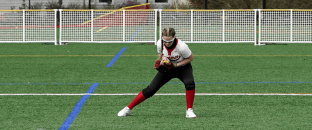*Note: products listed on Bases Loaded Softball are selected by our softball players, coaches, and team of enthusiast writers and editors. Buying softball products through our links may earn us a commission with no additional cost to you.
Sliding is one of the signature moves of softball that not only looks great, but is also an important technical skill to master.
While sliding may seem easy, it’s actually a skill that requires proper technique, timing, and discipline. Moreover, there are only certain times when sliding is necessary—and it’s barely ever because it’s a stylish way to end off a play. The biggest reason to slide is because it allows a player to make it to a base without slowing down their momentum, or overstepping over the base due to too much moment. Rather than trying to slow down your momentum, you can simply drop down and slide right up to the base.
Slide improperly, or at the wrong time, and a player can risk injury. But if a player knows how and when to slide, this move can actually have the opposite effect: preventing a player from slamming into the shortstop, or whatever player is hovering over the base waiting to make a tag.
Here’s how to slide in softball, so you can get to the base as quickly as possible with the least likely change of getting tagged.
Are sliding pants/shorts necessary?
Although sliding pants/shorts are not a requirement in any softball leagues, they will certainly help you to prevent abrasions, bruises, and other injuries. For this reason, they will also give you extra confidence on the field—you don’t want to be second guessing yourself before making a potentially game-making slide because you’re nervous about getting gravel lodged in your thighs.
Some sliding shorts are also designed with an additional layer of padding along the hips. This can help protect you from hip-injuries that could not only compromise your ability to continue playing softball at the top of your game, but could affect your life in other negative ways.
If you’re trying to decide between sliding shorts or sliding pants, just think to yourself: are my knees and calfs important to me? Sure, shorts are light and breezy. You may be generally more comfortable in shorts—up until the point that you injure your knees or the lower half of your legs! Even if pants are hotter and less comfortable, it’s worth it to invest in a pair of sliding pants so that you’re protected from the ground up. Trust us! While you might prefer to wear shorts, we’re confident that you’ll be much more happy in the end with legs that are injury-free so you can preserve your mobility, skin, and continue playing softball well into the future.
Wondering what kind of softball sliding pants to buy? Take a look at these highly rated sliding pants from Mizuno and Under Armour.
🏆 Some recommended Softball sliding pants with great reviews 🏆
How to slide in Softball for Beginners
Step 1: The basic slide is fairly easy to pull off. But the first step to sliding actually starts before the game: make sure you’re wearing proper clothing. This means coming to the game prepared with a pair of sliding pants. These will eliminate any fear of injury, or dirtying your pants. If you try sliding with shorts, you may end up with rocks in the bare skin on your legs.
Step 2: Start your slide roughly four or five steps away from the base. Begin by bending your knees, and shifting your weight back and to the left side of your body so that your energy begins to transfer down your body to your feet. At the same time, bend your left leg and bring it up behind your right leg, while straightening out your right leg. Your two legs together should be in the shape of a 4. At this time you should already be moving from a standing position to a horizontal sliding position.
Step 3: Keep leaning backwards and allow your body to slide. Keep your arms tucked in close to your body, elevated off the ground but not up in the air. Your arms shouldn’t drag on the ground at any point. Keep your right leg straight and extended with your toe pointed, so that your toe comes in contact with the base first. Once you’re touching the base, you’re safe.
back to menu ↑How to hook slide in Softball
A hook slide is a tricky maneuver that’s used when you’re trying to avoid getting tagged on your way to the base. This slide will require time and practice to learn and pull off properly in gameplay.
Step 1: Start your slide roughly two or three steps away from the base. Come at it from the side, and begin your slide, shifting your weight back and to your left leg, curling it up behind your outstretched right leg in the shape of a 4. Don’t slide directly at the base, but rather, slide towards the outside of the base.
Step 2: As you slide past the base, extend your left hand out so you can touch the base with your hand. Keep your left hand touching the base at all times, and don’t let go of it until the umpire calls you safe.
back to menu ↑How to slide head first in Softball
According to the official softball rules, sliding head first into a base is not allowed. So if you’re planning to try a head-first slide, first check the rules of your league to make sure it’s permitted. If you’re just playing a casual game with friends, establish these rules before the game. It’s also important to only execute this slide if you’re 100% confident in your ability to do so. This slide has the highest risk of injury out of any slide.
Step 1: Make sure you’re wearing sliding pants, a thick shirt that’s tucked into your pants, and wearing gloves and a helmet.
Step 2: Begin the dive by shifting your weight towards the left side of your body and forward. Keep slightly to the left of the base. As you begin to torpedo forward towards the base, extend your right hand out towards the base.
Step 3: Don’t touch the ground prematurely. Only bring your hand down completely to the ground when it’s overtop of the base, so that you can touch it and render yourself safe. Touching the outside corner of the base will give you the highest chance of avoiding a tag.
How to pop up slide in Softball
A pop up slide allows you to go from running, to sliding, and back to standing again all in one smooth motion. The purpose of this slide is to get to the base safely, then immediately being ready to run again if necessary.
Step 1: Start your slide roughly four or five steps away from the base. Begin by bending your knees, and shifting your weight back and to the left side of your body so that your energy begins to transfer down your body to your feet. At the same time, bend your left leg and bring it up behind your right leg, while straightening out your right leg. Your two legs together should be in the shape of a 4.
Step 2: Keep both hands up away from the ground. Slide on the ground on your bent back leg. The top back part of your straight leg will also likely be making contact with the ground as your slide. Keep this top leg extended with your foot out, until your foot makes contact with the base.
Step 3: As your foot touches the base, allow your momentum to push your upper body forward. As you’re moving forward, push up off the ground with your bent back leg. The combination of your momentum, pushing yourself up with this back leg, and moving your upper body forwards, should allow you to pop up quickly onto your feet.












